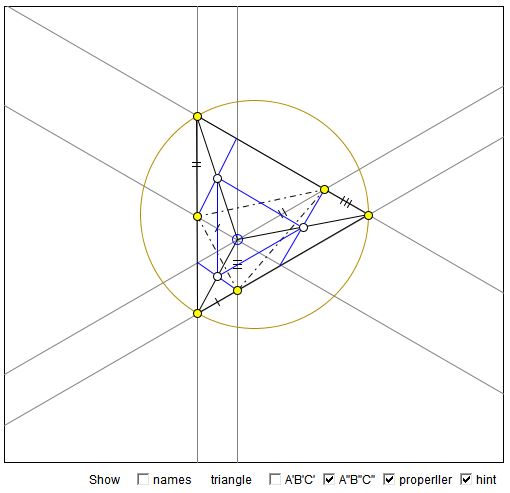Pompeiu's Theorem
What Is It?
A Mathematical Droodle
| What if applet does not run? |
|Activities| |Contact| |Front page| |Contents| |Geometry|
Copyright © 1996-2018 Alexander BogomolnyPompeiu's Theorem
The applet illustrates a theorem by D. Pompeiu (1873 - 1954)
For P not on the circumcircle of an equilateral ΔABC, there exists a triangle with side lengths equal to PA, PB, and PC.
(The triangle in question is known as Pompeiu's triangle.)

For a proof, pass through P lines parallel to the sides to obtain points A', B', C' (or A'', B'', C'') on BC, AC, and AB, respectively. There are two triangles to consider: A'B'C' and A''B''C''.
Then, for example, quadrilateral A'CB'P is an isosceles trapezoid so that
For P on the circumcircle, Pompeiu's triangles degenerates into a straight line.
(There is another proof.)
Hubert Shutrick has observed that the triangles A'B'C' and A''B''C'' are obtained from each other by a rotation through 60°. This is because each of the three triangles PA'A'', PB'B'', PC'C'' is equilateral.
He found a relationship between angles in Pampeiu's triangle and and some angles in the base triangle. For example,
∠B'A'C' = ∠B'A'P + ∠C'A'P = ∠B'CP + ∠C'BP = ∠BPC - 60°.
This is because A'CB'P and A'BC'P are isosceles trapezoids which are cyclic polygons. Angles A'B'C' and A'C'B' are treated similarly.
Naturally, since triangles A'B'C' and A''B''C'' are congruent, the angles of the latter satisfy the same identities. Or, by direct argument,
∠B''A''C'' = ∠B''C''P + ∠C''A''P = ∠B''CP + ∠C''AP = ∠BPC - 60°.
Hubert also came up with an alternative proof for points P inside the triangle. The argument is very straightforward. Indeed, let PA be the longest among the three segments, PA, PB, PC. To prove the theorem suffice it to establish the inequality
PA < PB + PC.
However observed that PA is shorter than any of the sides of the triangle, BC in particular. Now, applying the triangle inequality to ΔPBC gives
PA < BC < PB + PC
and we are done.
As an aside, triangles A'B'C' and A''B''C'' mentioned previously form the configuration of the Asymmetric Propeller. The midpoints At, Bt, Ct of B''C', C''A', and A''B', respectively are the midpoints of PA, PB, and PC so that the equilateral Δ AtBtCt has sides parallel to those of ΔABC and is a homothetic image of the latter with center P and coefficient 1/2. This is so because, for example, the quadrilateral A'BC''P is a parallelogram, implying that the midpoint of A'C'' is also the midpoint of PB.
(There is a converse construction of finding an eqilateral triangle.)
References
- R. Honsberger, Mathematical Delights, MAA, 2004, 5-6
- S. Savchev, T. Andreescu, Mathematical Miniatures, MAA, 2003, 89-90
|Activities| |Contact| |Front page| |Contents| |Geometry|
Copyright © 1996-2018 Alexander Bogomolny73581158
